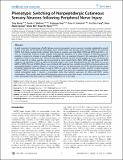| dc.contributor.author | Wang, Ting | |
| dc.contributor.author | Molliver, Derek C. | |
| dc.contributor.author | Jing, Xiaotang | |
| dc.contributor.author | Schwartz, Erica S. | |
| dc.contributor.author | Yang, Fu-Chia | |
| dc.contributor.author | Samad, Omar Abdel | |
| dc.contributor.author | Ma, Qiufu | |
| dc.contributor.author | Davis, Brian M. | |
| dc.date.accessioned | 2012-04-19T19:25:51Z | |
| dc.date.issued | 2011 | |
| dc.identifier.citation | Wang, Ting, Derek C. Molliver, Xiaotang Jing, Erica S. Schwartz, Fu-Chia Yang, Omar Abdel Samad, Qiufu Ma, and Brian M. Davis. 2011. Phenotypic switching of nonpeptidergic cutaneous sensory neurons following peripheral nerve injury. PLoS ONE 6(12): e28908. | en_US |
| dc.identifier.issn | 1932-6203 | en_US |
| dc.identifier.uri | http://nrs.harvard.edu/urn-3:HUL.InstRepos:8603492 | |
| dc.description.abstract | In adult mammals, the phenotype of half of all pain-sensing (nociceptive) sensory neurons is tonically modulated by growth factors in the glial cell line-derived neurotrophic factor (GDNF) family that includes GDNF, artemin (ARTN) and neurturin (NRTN). Each family member binds a distinct GFRα family co-receptor, such that GDNF, NRTN and ARTN bind GFRα1, -α2, and -α3, respectively. Previous studies revealed transcriptional regulation of all three receptors in following axotomy, possibly in response to changes in growth factor availability. Here, we examined changes in the expression of GFRα1-3 in response to injury in vivo and in vitro. We found that after dissociation of adult sensory ganglia, up to 27% of neurons die within 4 days (d) in culture and this can be prevented by nerve growth factor (NGF), GDNF and ARTN, but not NRTN. Moreover, up-regulation of ATF3 (a marker of neuronal injury) in vitro could be prevented by NGF and ARTN, but not by GDNF or NRTN. The lack of NRTN efficacy was correlated with rapid and near-complete loss of GFRα2 immunoreactivity. By retrogradely-labeling cutaneous afferents in vivo prior to nerve cut, we demonstrated that GFRα2-positive neurons switch phenotype following injury and begin to express GFRα3 as well as the capsaicin receptor, transient receptor potential vanilloid 1(TRPV1), an important transducer of noxious stimuli. This switch was correlated with down-regulation of Runt-related transcription factor 1 (Runx1), a transcription factor that controls expression of GFRα2 and TRPV1 during development. These studies show that NRTN-responsive neurons are unique with respect to their plasticity and response to injury, and suggest that Runx1 plays an ongoing modulatory role in the adult. | en_US |
| dc.language.iso | en_US | en_US |
| dc.publisher | Public Library of Science | en_US |
| dc.relation.isversionof | doi:10.1371/journal.pone.0028908 | en_US |
| dc.relation.hasversion | http://www.ncbi.nlm.nih.gov/pmc/articles/PMC3244441/pdf/ | en_US |
| dash.license | LAA | |
| dc.subject | biology | en_US |
| dc.subject | molecular cell biology | en_US |
| dc.subject | gene expression | en_US |
| dc.subject | neuroscience | en_US |
| dc.subject | neurochemistry | en_US |
| dc.subject | neurochemicals | en_US |
| dc.subject | nerve growth factor | en_US |
| dc.subject | neuropeptides | en_US |
| dc.subject | neurobiology of disease and regeneration | en_US |
| dc.title | Phenotypic Switching of Nonpeptidergic Cutaneous Sensory Neurons Following Peripheral Nerve Injury | en_US |
| dc.type | Journal Article | en_US |
| dc.description.version | Version of Record | en_US |
| dc.relation.journal | PLoS ONE | en_US |
| dash.depositing.author | Ma, Qiufu | |
| dc.date.available | 2012-04-19T19:25:51Z | |
| dc.identifier.doi | 10.1371/journal.pone.0028908 | * |
| dash.contributor.affiliated | Yang, Fu-Chia | |
| dash.contributor.affiliated | Ma, Qiufu | |


